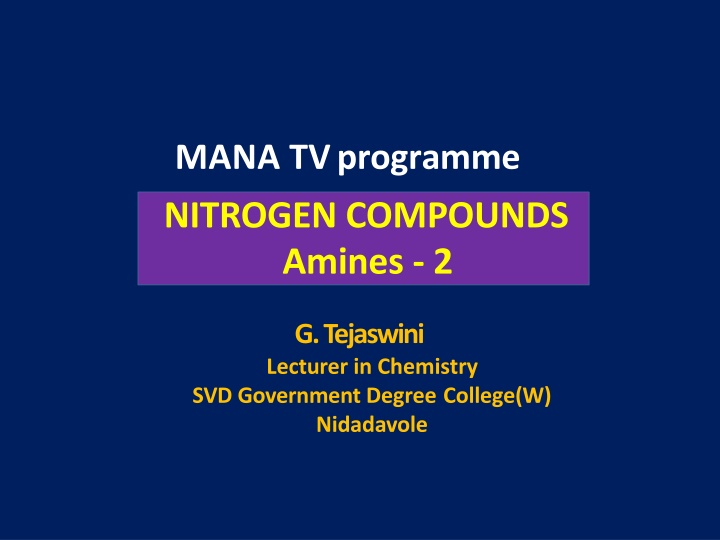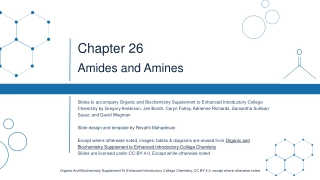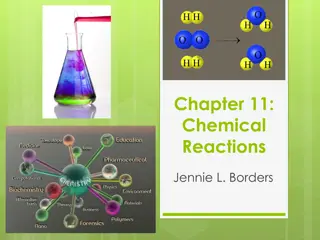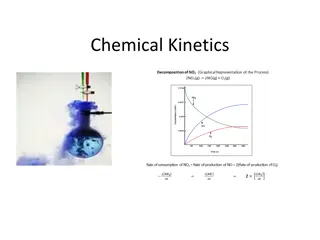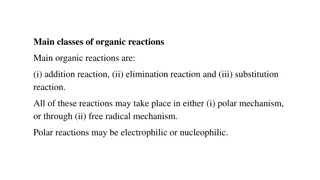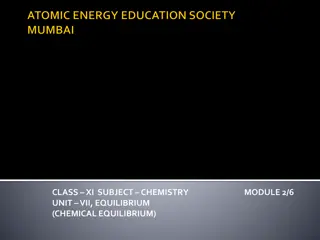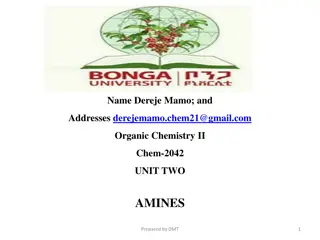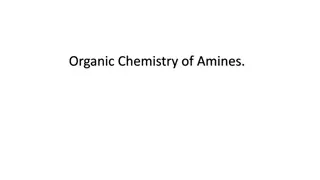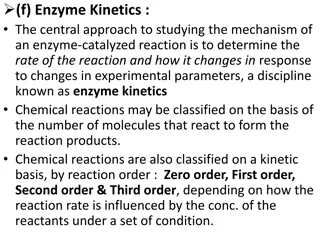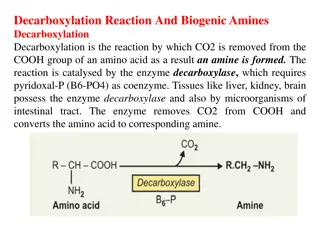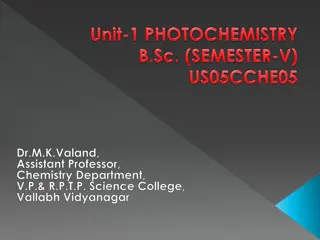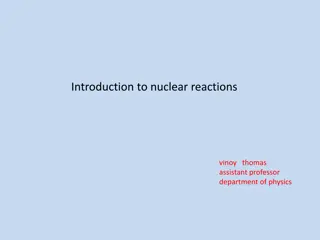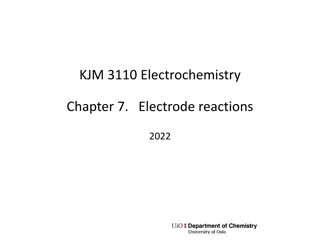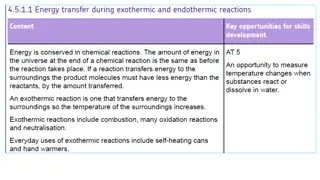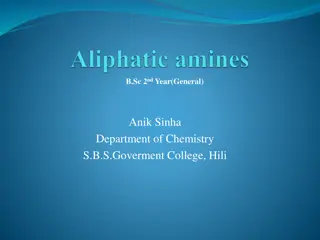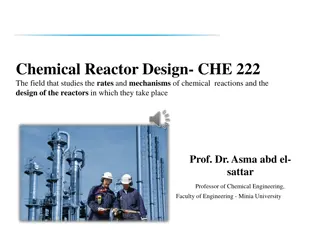Chemical Reactions of Amines
Aromatic amines have a unique C-N bond character due to resonance stabilization, affecting their basic nature. Alkylation and acylation reactions transform primary amines into secondary and tertiary amines. Carbylamine reaction generates isocyanides from primary amines. Explore electrophilic substitution reactions of aniline.
Download Presentation

Please find below an Image/Link to download the presentation.
The content on the website is provided AS IS for your information and personal use only. It may not be sold, licensed, or shared on other websites without obtaining consent from the author.If you encounter any issues during the download, it is possible that the publisher has removed the file from their server.
You are allowed to download the files provided on this website for personal or commercial use, subject to the condition that they are used lawfully. All files are the property of their respective owners.
The content on the website is provided AS IS for your information and personal use only. It may not be sold, licensed, or shared on other websites without obtaining consent from the author.
E N D
Presentation Transcript
MANA TV programme NITROGEN COMPOUNDS Amines - 2 G. Tejaswini Lecturer in Chemistry SVD Government Degree College(W) Nidadavole
Aromatic Amines In aromatic amines, the C N bond is slightly stronger due to the partial double bond character which arises as a result of delocalisation of lone pair of N with the benzene ring.
Basic nature of Aromatic Amines: The basic strength of aromatic amine is less than that of ammonica pKb (4.74). The reason for this is that N in aniline participates in the resonance stabilisation. Due to the partial positive charge on N , the electron density on N Decreases. Therefore the basic character decreases. C6H5NH2+H2O C6H5N+H3+HO- The basic character of N-methyl aniline, N,N- di methyl aniline is greater than that of aniline.Here -CH3 is +I group.This increases the electron density on N or decreases to some extent the positive charge on N in ammonium ion N,N- di methyl aniline> N-methyl aniline> Aniline
Chemical Reactions 1) Alkylation Alkylation of 1oamine generates 2oamine, 3oamine and finally the quaternary salts. 2) Acylation Acylation is the reaction with acid chlorides, anhydrides and esters. These occur by nucleophilic substitution reactions. The reaction is proceeded by the replacement of hydrogen atom of NH2or >N H group by the acyl group (RCOX). RNH2+ R COCl R CO NHR an N-substituted amide R2NH + R COCl R CO.NR2an N,N disubstituted amide
Carbylamine Reaction: This reaction is given only by primary aminesPrimary amines when heated with chloroform and alcoholic caustic potash give isocynaides (carbylamines) having very unpleasant smell C2H5NH2+ CHCl3+ 3KOH C2H5NC + 3KCl + 3H2O Ethylamine Ethyl isocyanide C6H5NH2+ CHCl3+ 3KOH C6H5NC + 3KCl + 3H2O Aniline Phenyl isocyanide
a) The Reaction of 1oAmines: b) The Reaction of 2oAmines:
Electrophilic substitution Reactions: Aniline is ortho and para directing group towards Electrophilic substitution reactions. This is because high electron density at ortho and para positions Bromination:
Diazonium Salts of amines: The name suggests that, the compound has two nitrogen atoms (diazo) and the whole group has a positive charge (ium). There is also an anion to balance it (It is a salt) So, the possible structure can be: RN2+X- These diazonium salts are prepared by treating a primary amine with NaNO2in presence of con. HCl, the temperature being 0-5 C.
Mechanism for Diazotization Step 1: Generation of electrophile Step 2:Attack of electrophile https://files.askiitians.com/cdn1/images/2014724-132028969-5423-nitrosonium_ion_with_amine_reaction.png
Separation of Amines Hinsberg method: Hinsberg reagent is Benzenesulphonyl Chloride Cl The mixture of amines is treated with benzenesulphonyl Chloride and shaken with alkali solution when the three Amines react in different ways based on this we can separate them. Primary amine forms alkylbenzene sulphonamide which dissolves in alkali to form potassium salt or monoalkyl sulphonamide Secondary amine forms dialkyl sulphonamide which does not form salt with alkali and hence, remains insoluble in alkali solution. Tertiary amine does not react with the Hinsberg reagent S O O
KOH C6H5SO2NHR C6H5SO2NKR C6H5SO2Cl +RNH2 Potassium salt ofMonoalkyl Benzene sulphonamide (soluble in water) 1o Amine Monoalkyl Benzene sulphonamide Benzene sulphonyl chloride KOH C6H5SO2NR2 No action C6H5SO2Cl +R2NH (insoluble in water soluble in ether) 2o Amine Dialkyl Benzene sulphonamide Benzene sulphonyl chloride C6H5SO2Cl +R3N No reaction ( soluble in ether)
